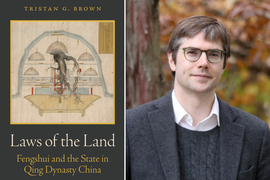Disputes over mining were common in late imperial China, during the Qing Dynasty. For instance, in the 1870s, Wu Tang, the governor-general of Sichuan province, enacted an outright ban on mining, despite an apparent economic need for it.
The rationale Wu Tang and other mining opponents often used to support their decisions? Fengshui.
That’s right, fengshui, the same concept contemporary Westerners associate with interior design — although it was a rather different thing in its place of origin. Fengshui was not a guide to sofa placement, but a long-established body of Chinese knowledge about the natural environment in relationship to the constructed world.
“Fengshui literally means wind and water,” says MIT historian Tristan Brown. “I think you can define it as an ever-evolving knowledge system of the natural and built environment that applied cosmological principles to the analysis of land for the siting of significant projects.”
Brown has written a new book about this rich and overlooked past, “Laws of the Land: Fengshui and the State in Qing Dynasty China,” published this month by Princeton University Press. In it, he examines the place of fengshui in Chinese society, specifically as a doctrine of knowledge used to inform legal cases and public policy decisions at a time of industrialization and modernization. In this sense, fengshui was not a matter of private taste, but a crucial part of the public sphere.
Like a government report
While not a firmly codified body of thought, fengshui involves the elemental forces of yin and yang, which interact to create the “five agents,” with the qualities of fire, water, metal, wood, and earth. These are the basic parts of qi, the vital essence of the world. In China, there were two dominant modes of fengshui: the Compass School, which used a geomatic compass to assess the placement of structures, and the Form School, which focused more on the overall balance of built sites within the larger forms of the natural landscape.
“Laws of the Land” is the end product of doctoral work by Brown, who is the S.C. Fang Chinese Language and Culture Career Development Professor in MIT’s history section. Through original archival research in China, he analyzed hundreds of legal cases using fengshui, often involving the placement of gravesites, houses, temples, palaces, mining, industrial construction, and more.
Wu Tang, for one, ordered the Chengdu Plain of the Sichuan basin to be mapped by geomantic compass, creating a body of knowledge he could use in legal and policy matters.
“This is like a federal government report today in trying to debate a pipeline question, [it details] where the key places are, where everything is,” Brown says. “You can read that map as a super-fascinating specimen in the history of law and the environment.”
Indeed, as Brown emphasizes, the use of fengshui in public matters, occasionally remarked on by Westerners as a kind of eccentricity, was a recognizable effort to find sources of authority during disagreements about modernization.
“These Qing officials were not naïve, they were not backwards, including the ones who invoked fengshui to say [changes were] going to be bad,” Brown says.
And while explaining how fengshui was deployed in these cases, “Laws of the Land” also provides insights about industrialization in China. Some of the clearest disputes involving fengshui were concerned foreign investment in railroads, the telegraph, and mining in the late 19th century. But as Brown’s work shows, economic growth was creating pressures and public disputes well before that.
“In the 19th century, prior to railways and telegraphs even being debated, there was a rising population in China, there was increasing pressure on local environments, and the government was really just trying to hang on,” Brown says. “It’s a society and a legal system coming to terms with dramatic environmental and economic change, and trying to negotiate those shifts in the law through fengshui.”
From mining to the living room
“Laws of the Land” may also put the contemporary, Westernized, scaled-down version of fengshui into better perspective. Many Westerners encountered fengshui as part of the global rise in interest in Asian culture that dates back about 50 or 60 years. The scale and ambition of fengshui has certainly changed, compared to the way it was originally practiced in China, and Brown’s book helps show what has evolved, and remained intact.
“Fengshui gets rediscovered in the 1960s and the 1970s in the West as a kind of New Age knowledge, for harmonizing the environment with human beings, harmonizing living spaces, eventually living rooms and kitchens and all of that,” Brown says. “I think this book can also show how fengshui got where it is today, why it appears in The New York Times in the design section. There is a long history of people engaging fengshui and not necessarily knowing what it is, but this book may help clarify that.”
“Laws of the Land” has received praise from other historians. Jonathan Schlesinger, an Indiana University historian who studies both the Qing dynasty and environmental issues, has called it “an impressive, fine-combed reading of sources that paint a vivid picture of fengshui’s signature importance within local life and Qing law.”
Brown says he hopes to draw a wide audience of people with a variety of interests, given that his book brings together ideas about Chinese history, the law, design, religion and spirituality, and more. Academically, studying fengshui was once the province of anthropologists, but Brown’s book places the subject in new terrain as a part of legal history.
“The book builds on what’s come before and I hope contributes to what’s coming next,” Brown says. “For readers, and for students and scholars of architecture, design, law, religion, the environment, I hope there’s something here for everyone.”









